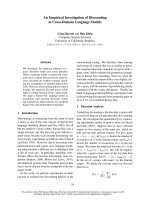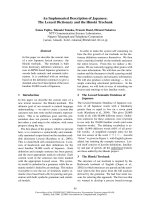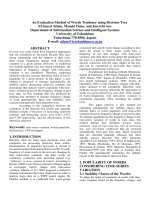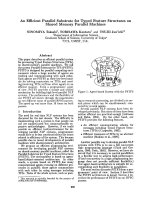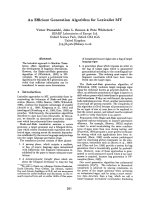Báo cáo khoa học: "An Efficient Implementation of a New POP Model" doc
Bạn đang xem bản rút gọn của tài liệu. Xem và tải ngay bản đầy đủ của tài liệu tại đây (353.19 KB, 8 trang )
An Efficient Implementation of a New POP Model
Rens Bod
ILLC, University of Amsterdam
School of Computing, University of Leeds
Nieuwe Achtergracht 166, NL-1018 WV Amsterdam
Abstract
Two apparently opposing DOP models
exist in the literature: one which computes
the parse tree involving the most frequent
subtrees from a treebank and one which
computes the parse tree involving the
fewest subtrees from a treebank. This
paper proposes an integration of the two
models which outperforms each of them
separately. Together with a PCFG-
reduction of DOP we obtain improved
accuracy and efficiency on the Wall Street
Journal treebank Our results show an 11%
relative reduction in error rate over
previous models, and an average
processing time of 3.6 seconds per WSJ
sentence.
1 Introduction: A Little History
1.1 DOP and its Doppelgangers
1
The distinctive feature of the DOP approach when
it was proposed in 1992 was to model sentence
structures on the basis of previously observed
frequencies of sentence structure fragments,
without imposing any constraints on the size of
these fragments. Fragments include, for instance,
subtrees of depth 1 (corresponding to context-free
rules) as well as entire trees.
To appreciate these innovations, it should be
noted that the model was radically different from
all
other statistical parsing models at the time.
Other models started off with a
predefined
grammar and used a corpus only for estimating
the rule probabilities (as e.g. in Fujisaki et al.
1989; Black et al. 1992, 1993; Briscoe and
I
Thanks to Ivan Sag for this pun.
Waegner 1992; Pereira and Schabes 1992). The
DOP model, on the other hand, was the first
model (to the best of our knowledge) that
proposed not to train a predefined grammar on a
corpus, but to directly use corpus fragments as a
grammar. This approach has now gained wide
usage, as exemplified by the work of Collins
(1996, 1999), Charniak (1996, 1997), Johnson
(1998), Chiang (2000), and many others.
The other innovation of DOP was to take (in
principle) all corpus fragments, of any size, rather
than a small subset. This innovation has not
become generally adopted yet: many approaches
still work either with local trees, i.e. single level
rules with limited means of information
percolation, or with restricted fragments, as in
Stochastic Tree-Adjoining Grammar (Schabes
1992; Chiang 2000) that do not include non-
lexicalized fragments. However, during the last
few years we can observe a shift towards using
more and larger corpus fragments with fewer
restrictions. While the models of Collins (1996)
and Eisner (1996) restricted the fragments to the
locality of head-words, later models showed the
importance of including context from higher
nodes in the tree (Charniak 1997; Johnson
1998a). The importance of including nonhead-
words has become uncontroversial (e.g. Collins
1999; Charniak 2000; Goodman 1998). And
Collins (2000) argues for "keeping track of counts
of arbitrary fragments within parse trees", which
has indeed been carried out in Collins and Duffy
(2002) who use exactly the same set of (all) tree
fragments as proposed in Bod (1992).
Thus the major innovations of
DOP are:
1. the use of corpus fragments rather than
grammar rules,
19
2. the use of arbitrarily large fragments
rather than restricted ones
Both have gained or are gaining wide usage, and
are also becoming relevant for theoretical
linguistics (see Bod et al. 2003a).
1.2 DOP1 in Retrospective
One instantiation of DOP which has received
considerable interest is the model known as
DOP1
2
(Bod 1992). DOP1 combines subtrees
from a treebank by means of node-substitution
and computes the probability of a tree from the
normalized frequencies of the subtrees (see
Section 2 for a full definition). Bod (1993)
showed how standard parsing techniques can be
applied to DOP1 by converting subtrees into
rules. However, the problem of computing the
most probable parse turns out to be NP-hard
(Sima'an 1996), mainly because the same parse
tree can be generated by exponentially many
derivations. Many implementations of DOP1
therefore estimate the most probable parse by
Monte Carlo techniques (Bod 1998; Chappelier &
Rajman 2000), or by Viterbi n-best search (Bod
2001), or by restricting the set of subtrees
(Sima'an 1999; Chappelier et al. 2002). Sima'an
(1995) gave an efficient algorithm for computing
the parse tree generated by the most probable
derivation, which in some cases is a reasonable
approximation of the most probable parse.
Goodman (1996, 1998) developed a
polynomial time PCFG-reduction of DOP1
whose size is linear in the size of the training set,
thus converting the exponential number of
subtrees to a compact grammar. While
Goodman's method does still not allow for an
efficient computation of the most probable parse
in DOP1, it does efficiently compute the
"maximum constituents parse", i.e. the parse tree
which is most likely to have the largest number of
correct constituents.
Johnson (1998b, 2002) showed that DOP1's
subtree estimation method is statistically biased
and inconsistent. Bod (2000a) solved this
problem by training the subtree probabilities by a
2
See Bod et al. (2003b) for an overview and history of
other DOP models.
maximum likelihood procedure based on
Expectation-Maximization. This resulted in a
statistically consistent model dubbed ML-DOP.
However, ML-DOP suffers from overlearning if
the subtrees are trained on the same treebank trees
as they are derived from. Cross-validation is
needed to avoid this problem. But even with
cross-validation, ML-DOP is outperformed by
the much simpler DOP1 model on both the ATIS
and OVIS treebanks (Bod 2000b).
Bonnema et al. (1999) observed that another
problem with DOP1's subtree-estimation method
is that it provides more probability to nodes with
more subtrees, and therefore more probability to
larger subtrees. As an alternative, Bonnema et al.
(1999) propose a subtree estimator which reduces
the probability of a tree by a factor of two for each
non-root non-terminal it contains. Bod (2001)
used an alternative technique which samples a
fixed number of subtrees of each depth and which
has the effect of assigning roughly equal weight to
each node in the training data. Although Bod's
method obtains very competitive results on the
Wall Street Journal (WSJ) task, the parsing time
was reported to be over 200 seconds per sentence
(Bod 2003).
Collins & Duffy (2002) showed how the
perceptron algorithm can be used to efficiently
compute the best parse with DOP1's subtrees,
reporting a 5.1% relative reduction in error rate
over the model in Collins (1999) on the WSJ.
Goodman (2002) furthermore showed how
Bonnema et al.'s (1999) and Bod's (2001)
estimators can be incorporated in his PCFG-
reduction, but did not report any experiments with
these reductions.
This paper presents the first published results
with Goodman's PCFG-reductions of both
Bonnema et al.'s (1999) and Bod's (2001)
estimators on the WSJ. We show that these
PCFG-reductions result in a 60 times speedup in
processing time w.r.t. Bod (2001, 2003). But
while Bod's estimator obtains state-of-the-art
results on the WSJ, comparable to Charniak
(2000) and Collins (2000), Bonnema et al.'s
estimator performs worse and is comparable to
Collins (1996).
In the second part of this paper, we extend our
experiments with a new notion of the best parse
tree. Most previous notions of best parse tree in
20
DOP1 were based on a probabilistic metric, with
Bod (2000b) as a notable exception, who used a
simplicity metric based on the shortest derivation.
We show that a combination of a probabilistic and
a simplicity metric, which chooses the simplest
parse from the
n
likeliest parses, outperforms the
use of these metrics alone. Compared to Bod
(2001), our results show an 11% improvement in
terms of relative error reduction and a speedup
which reduces the processing time from 220 to
3.6 seconds per WSJ sentence.
2 PCFG-Reductions of DOP
2.1 Formal Specification of DOP1
DOP1 parses new input by combining treebank-
subtrees by means of a leftmost node-subsitution
operation, indicated as 0. The probability of a
parse tree is computed from the occurrence-
frequencies of the subtrees in the treebank. That
is, the probability of a subtree
t
is taken as the
number of occurrences of
t
in the training set, I
t
I,
divided by the total number of occurrences of all
subtrees
t'
with the same root label as
t.
Let
r(t)
return the root label of
t:
I
t
i
E
t': r(t')=r(t) I 11
The probability of a derivation ti0 0t
n
is
computed by the product of the probabilities of its
subtrees
ti:
= Hi
p(ti)
An important feature of DOP1 is that there may
be several derivations that generate the same parse
tree. The probability of a parse tree
T
is the sum
of the probabilities of its distinct derivations. Let
tid
be the i-th subtree in the derivation
d
that
produces tree
T,
then the probability of
T is given
by
P(7)
=
Edrli
P(tid)
Thus DOP1 considers counts of subtrees of a
wide range of sizes in computing the probability
of a tree: everything from counts of single-level
rules to counts of entire trees. A disadvantage of
this model is that an extremely large number of
subtrees (and derivations) must be taken into
account. Fortunately, there exists a compact
PCFG-reduction of DOP1 that generates the same
trees with the same probabilities, as shown by
Goodman (1996, 2002). Here we will only sketch
this PCFG-reduction, which is heavily based on
Goodman (2002).
Goodman assigns every node in every tree a
unique number which is called its address. The
notation
A@k denotes the node at address
k
where
A is the nonterminal labeling that node. A new
nonterminal is created for each node in the
training data. This nonterminal is called
A k.
Nonterminals of this form are called "interior"
nonterminals, while the original nonterminals in
the parse trees are called "exterior" nontermimals.
Let
aj
represent the number of subtrees headed by
the node
A@j .
Let
a
represent the number of
subtrees headed by nodes with nonterminal A, that
is
a =Ej aj.
Goodman (1996, 2002) further illustrates this
by a node A
@j
of the following form:
A@j
B@k C@1
Figure 1. A node A
@j
To see how many subtrees it has, Goodman first
considers the possibilities of the left branch. There
are
bk
non-trivial subtrees headed by
B@k,
and
there is also the trivial case where the left node is
simply
B.
Thus there are
bk
+ 1 different
possibilities on the left branch. Similarly, there are
ci
+ 1 possibilities on the right branch. We can
create a subtree by choosing any possible left
subtree and any possible right subtree. Thus, there
are
aj= (bk+ 1)(ci + 1)
possible subtrees headed
by A
@j.
Goodman then gives a simple small PCFG
with the following property: for every subtree in
the training corpus headed by A, the grammar will
generate an isomorphic subderivation with
probability 1/a. Thus, rather than using the large,
explicit DOP1 model, one can also use this small
PCFG that generates isomorphic derivations, with
identical probabilities. Goodman's construction is
—
21
as follows. For the node in figure 1, the following
eight PCFG rules are generated, where the
number in parentheses following a rule is its
probability.
A1
—BC
Mad
A
BC
(11a)
Aj
BkC
(bklaj)
A —> BkC
(bkla)
Aj
BC1
(cilaj)
A
BC1
(cila)
Aj
BkCi
(bkcilaj)
A
BkCi
(bkcila)
Figure 2. PCFG-reduction of DOP1
Goodman then shows by simple induction that
subderivations headed by A with external
nonterminals at the roots and leaves, internal
nonterminals elsewhere have probability 1/a. And
subderivations headed by A1 with external
nonterminals only at the leaves, internal
nonterminals elsewhere, have probability
1/a1
(Goodman 1996). Goodman's main theorem is
that this construction produces PCFG derivations
isomorphic to DOP derivations with equal
probability. This means that summing up over
derivations of a tree in DOP yields the same
probability as summing over all the isomorphic
derivations in the PCFG.
Note that Goodman's reduction method does
still not allow for an efficient computation of the
most probable parse tree of a sentence: there may
still be exponentially many derivations generating
the same tree. But Goodman shows that with his
PCFG-reduction he can efficiently compute the
aforementioned maximum constituents parse.
Moreover, Goodman's PCFG reduction may also
be used to estimate the most probable parse by
Viterbi n-best search which computes the
n
most
likely derivations and then sums up the
probabilities of the derivations producing the
same tree. While Bod (2001) needed to use a very
large sample from the WSJ subtrees to do this,
Goodman's method can do the same job with a
more compact grammar.
2.2 PCFG-Reductions of Bod (2001) and
Bonnema et al. (1999)
DOP1 has a serious bias: its subtree estimator
provides more probability to nodes with more
subtrees (Bonnema et al. 1999). The amount of
probability given to two different training nodes
depends on how many subtrees they have, and,
given that the number of subtrees is an
exponential function, this means that some
training nodes could easily get hundreds or
thousands of times the weight of others, even if
both occur exactly once. Bonnema et al. (1999)
show that as a consequence too much weight is
given to larger subtrees, and that the parse
accuracy of DOP1 deteriorates if (very) large
subtrees are included. Although this property may
not be very harmful for small corpora with
relatively small trees, such as the ATIS, Bonnema
et al. give evidence that it leads to severe biases
for larger corpora such as the WSJ. There are
several ways to fix this problem. For example,
Bod (2001) samples a fixed number of subtrees
of each depth, which has the effect of assigning
roughly equal weight to each node in the training
data, and roughly exponentially less probability
for larger trees (see Goodman 2002: 12). Bod
reports state-of-the-art results with this method,
and observes no decrease in parse accuracy when
larger subtrees are included (using subtrees up to
depth 14). Yet, his grammar contains more than 5
million subtrees and processing times of over 200
seconds per WSJ sentence are reported (Bod
2003).
In this paper, we will test a simple extension of
Goodman's compact PCFG-reduction of DOP
which has the same property as the normalization
proposed in Bod (2001) in that it assigns roughly
equal weight to each node in the training data. Let
a
be the number of times nonterminals of type A
occur in the training data. Then we slightly
modify the PCFG-reduction in figure 2 as
follows:
A•
1
BC
(1/ai)
A—BC
(1Iaa)
A•
BkC
(bklaj)
A
BkC
(bklaa)
A•
(cilaj)
A
(cilaa)
A.
BkCi
(bkcilaj)
A
BkCi
(bkcilaa)
Figure 3. PCFG-reduction of Bod (2001)
We will also test the proposal by Bonnema et al.
(1999) which reduces the probability of a subtree
by a factor of two for each non-root nonterminal it
contains. It easy to see that this is equivalent to
reducing the probability of a tree by a factor of
four for each pair of nonterminals it contains,
22
resulting in the PCFG reduction in figure 4.
Tested on the OVIS corpus, Bonnema et al.'s
proposal obtains results that are comparable to
Sima'an (1999) see Bonnema et al. (1999). This
paper presents the first published results with this
estimator on the WSJ.
A
l
BC
(1/4)
A—
BC
(1/4a)
A•
BkC
(1/4)
A
BkC
(1/4a)
A•
BC/
(1/4)
A
BO
(114a)
A•
BkCi
(1/4)
A
BkCi
(114a)
Figure 4. PCFG-reduction of Bonnema (1999)
By using these PCFG-reductions we can thus
parse with
all
subtrees in polynomial time.
However, as mentioned above, efficient parsing
does not necessarily mean efficient
disambiguation: the exact computation of the
most probable parse remains exponential. In this
paper, we will estimate the most probable parse
by computing the 10,000 most probable
derivations by means of Viterbi n-best, from
which the most likely parse is estimated by
summing up the probabilities of the derivations
that generate the same parse.
3 A New Notion of the Best Parse Tree
3.1 Two Criteria for the Best Parse Tree:
Likelihood vs. Simplicity
Most DOP models, such as in Bod (1993),
Goodman (1996), Bonnema et al. (1997),
Sima'an (2000) and Collins & Duffy (2002), use
a likelihood criterion in defining the best parse
tree: they take (some notion of) the most likely
(i.e. most probable) tree as a candidate for the best
tree of a sentence. We will refer to these models
as
Likelihood
-
DOP
models, but in this paper we
will specifically mean by "Likelihood-DOP" the
PCFG-reduction of Bod (2001) given in Section
2.2.
In Bod (2000b), an alternative notion for the
best parse tree was proposed based on a
simplicity criterion: instead of producing the most
probable tree, this model produced the tree
generated by the shortest derivation with the
fewest training subtrees. We will refer to this
model as
Simplicity
-
DOP.
In
case the shortest
derivation is not unique, Bod (2000b) proposes to
back off to a frequency ordering of the subtrees.
That is, all subtrees of each root label are assigned
a rank according to their frequency in the
treebank: the most frequent subtree (or subtrees)
of each root label gets rank 1, the second most
frequent subtree gets rank 2, etc. Next, the rank of
each (shortest) derivation is computed as the sum
of the ranks of the subtrees involved. The
derivation with the smallest sum, or highest rank,
is taken as the final best derivation producing the
best parse tree in Simplicity-DOP.
3
Although Bod (2000b) reports that Simplicity -
DOP is outperformed by Likelihood-DOP, its
results are still rather impressive for such a simple
model. What is more important, is, that the best
parse trees predicted by Simplicity-DOP are quite
different from the best parse trees predicted by
Likelihood-DOP. This suggests that a model
which combines these two notions of best parse
may boost the accuracy.
3.2 Combining Likelihood-DOP and
Simplicity-DOP: SL-DOP & LS-DOP
The underlying idea of combining Likelihood-
DOP and Simplicity-DOP is that the parser
selects the simplest tree from among the
n
most
probable trees, where
n
is a free parameter. A
straightforward alternative would be to select the
most probable tree from among the
n
simplest
trees. We will
refer to the first combination
(which selects the simplest among the
n likeliest
trees) as
Simplicity
-
Likelihood
-
DO?
or
SL
-
DOP,
and to the second combination (which selects the
likeliest among the
n
simplest trees) as
Likelihood-Simplicity-DO?
or
LS-DOP.
Note that
for n=1, SL-DOP is equal to Likelihood-DOP,
since there is only one most probable tree to select
from, and LS-DOP is equal to Simplicity-DOP,
since there is only one simplest tree to select
from. Moreover, if
n
gets large, SL-DOP
converges to Simplicity-DOP while LS-DOP
converges to Likelihood-DOP. By varying the
parameter
n,
we will be able to compare
3
As in Bod (2002), we performed one adjustment to the
rank of a subtree: we averaged its rank by the ranks of all
its sub-subtrees.
23
4.1 Comparing the PCFG-Reductions of
Bod (2001) and Bonnema et al. (1999)
Likelihood-DOP, Simplicity-DOP and several
instantiations of SL-DOP and LS-DOP.
3.3 Computational Issues
Note that Goodman's PCFG-reduction method
summarized in Section 2 applies not only to
Likelihood-DOP but also to Simplicity-DOP. The
only thing that needs to be changed for
Simplicity-DOP is that all subtrees should be
assigned equal probabilities. Then the shortest
derivation is equal to the most probable derivation
and can be computed by standard Viterbi
optimization, which can be seen as follows: if
each subtree has a probability
p
then the
probability of a derivation involving
n
subtrees is
equal to
pn,
and since 0<p<1, the derivation with
the fewest subtrees has the greatest probability.
For SL-DOP and LS-DOP, we first compute
either n
likeliest or
n
simplest trees by means of
Viterbi optimization. Next, we either select the
simplest tree among the
n
likeliest ones (for SL -
DOP) or the likeliest tree among the
n
simplest
ones (for LS-DOP). In our experiments,
n
will
never be larger than 1,000.
4 Experiments
For our experiments we used the standard
division of the WSJ (Marcus et al. 1993), with
sections 2 through 21 for training (approx. 40,000
sentences) and section 23 for testing (2416
sentences 100 words); section 22 was used as
development set. As usual, all trees were stripped
off their semantic tags, co-reference information
and quotation marks. Without loss of generality,
all trees were converted to binary branching (and
were reconverted to n-ary trees after parsing). We
employed the same unknown (category) word
model as in Bod (2001), based on statistics on
word-endings, hyphenation and capitalization in
combination with Good-Turing (Bod 1998: 85 -
87). We used "evalb"
4
to compute the standard
PARSEVAL scores for our results (Manning &
Schiitze 1999). We focused on the Labeled
Precision (LP) and Labeled Recall (LR) scores, as
these are commonly used to rank parsing
systems.
4
/>Our first experimental goal was to compare the
two PCFG-reductions in Section 2.2, which we
will refer to resp. as Bod01 and Bon99. Table 1
gives the results of these experiments and
compares them with some other statistical parsers
(resp. Collins 1996, Charniak 1997, Collins 1999
and Charniak 2000).
Parser
LP
LR
40 words
Co1196
86.3
85.8
Char97
87.4
87.5
Co1199
88.7
88.5
Char00
90.1
90.1
Bod01
90.3
90.1
Bon99
86.7
86.0
100 words
Co1196
85.7
85.3
Char97
86.6
86.7
Co1199
88.3
88.1
Char00
89.5
89.6
Bod01
89.7
89.5
Bon99
86.2 85.6
Table 1. Bod (2001) and Bonnema et al. (1999)
compared to other parsers
While the PCFG reduction of Bod (2001) obtains
state-of-the-art results on the WSJ, comparable to
Charniak (2000), Bonnema et al.'s estimator
performs worse and is comparable to Collins
(1996). As to the processing time, the PCFG
reduction parses each sentence 100 words) in
3.6 seconds average, while the parser in Bod
(2001, 2003), which uses over 5 million subtrees,
is reported to take about 220 seconds per
sentence. This corresponds to a speedup of over
60 times. It should be mentioned that the best
precision and recall scores reported in Bod (2001)
are slightly better than the ones reported here (the
difference is only 0.2% for sentences 100
words). This may be explained by the fact our
best results in Bod (2001) were obtained by
testing various subtree restrictions until the
highest accuracy was obtained, while in the
current experiment we used all subtrees as given
by the PCFG-reduction. In the following section
24
we will see that our new definition of best parse
tree also outperforms the best results obtained in
Bod (2001).
first results of SL-DOP and LS-DOP with a
compact PCFG-reduction.
5 Conclusion
4.2 Comparing SL
-
DOP and LS
-
DOP
As our second experimental goal, we compared
the models SL-DOP and LS-DOP explained in
Section 3.2. Recall that for n=1, SL-DOP is equal
to the PCFG-reduction of Bod (2001) (which we
also called Likelihood-DOP) while LS-DOP is
equal to Simplicity-DOP. Table 2 shows the
results for sentences 100 words for various
values of
n.
SL-DOP
LP
LR
LS-DOP
LP
LR
89.7
89.5
87.4
87.0
5
90.1
90.0
87.9
87.4
10
90.6 90.4
88.5 88.1
11
90.7 90.7
88.5
88.1
12
90.8 90.7
88.5
88.1
13
90.8 90.7
88.6
88.3
14
90.8 90.7
88.6
88.3
15
90.7
90.6
88.6
88.3
20
90.3
90.1
88.9
88.7
50
89.5
89.2
89.3
89.0
100
88.1
87.5
89.7
89.4
1,000
87.4 87.0
89.7
89.4
Table 2. Results of SL-DOP and LS-DOP on the
WSJ (sentences 100 words)
Note that there is an increase in accuracy for both
SL-DOP and LS-DOP if the value of
n
increases
from 1 to 12. But while the accuracy of SL-DOP
decreases after
n=14
and converges to Simplicity -
DOP, the accuracy of LS-DOP continues to
increase and converges to Likelihood-DOP. The
highest accuracy is obtained by SL-DOP at
12
n
14: an LP of 90.8% and an LR of
90.7%. This is roughly an 11% relative reduction
in error rate over Charniak (2000) and Bod's
PCFG-reduction reported in Table 1. Compared
to the reranking technique in Collins (2000), who
obtained an LP of 89.9% and an LR of 89.6%,
our results show a 9% relative error rate
reduction.
While SL-DOP and LS-DOP have been
compared before in Bod (2002), especially in the
context of musical parsing, this paper presents the
The DOP approach is based on two distinctive
features: (1) the use of corpus fragments rather
than grammar rules, and (2) the use of arbitrarily
large fragments rather than restricted ones. While
the first feature has been generally adopted in
statistical NLP, the second feature has for a long
time been a serious bottleneck, as it results in
exponential processing time when the most
probable parse tree is computed.
This paper showed that a PCFG-reduction of
DOP in combination with a new notion of the
best parse tree results in fast processing times and
very competitive accuracy on the Wall Street
Journal treebank.
This paper also re-affirmed that the coarse-
grained approach of using all subtrees from a
treebank outperforms the fine-grained approach of
specifically modeling lexical-syntactic depen -
dencies (as e.g. in Collins 1999 and Charniak
2000).
References
Black, E., J. Lafferty and S. Roukos, 1992.
Development and Evaluation of a Broad-
Coverage Probabilistic Grammar of English-
Language Computer Manuals. Proceedings
ACL'92,
Newark, Delaware.
Black, E., R. Garside and G. Leech, 1993.
Statistically-Driven Computer Grammars of
English: The IBM/Lancaster Approach.
Rodopi:
Amsterdam-Atlanta.
Bod, R. 1992. Data Oriented Parsing,
Proceedings
COLING'92,
Nantes, France.
Bod, R. 1993. Using an Annotated Language
Corpus as a Virtual Stochastic Grammar,
Proceedings AAAI'93,
Washington D.C.
Bod, R. 1998.
Beyond Grammar: An Experience-
Based Theory of Language,
Stanford, CSLI
Publications.
Bod, R. 2000a. Combining Semantic and Syntactic
Structure for Language Modeling in Speech
Recognition.
Proceedings ICSLP'2000,
Beijing,
China.
Bod, R. 2000b. Parsing with the Shortest
Derivation,
Proceedings COLING'2 000,
Saarbriicken, Germany.
Bod, R. 2001. What is the Minimal Set of Subtrees
that Achieves Maximal Parse Accuracy?
Proceedings ACL'2001,
Toulouse, France.
25
Bod, R. 2002. A Unified Model of Structural
Organization in Language and Music.
Journal of
Artificial Intelligence Research
17, 289-308.
Bod, R. 2003. Do All Fragments Count?
Natural
Language Engineering,
9(2). (in press)
Bod, R., J. Hay and S. Jannedy (eds.), 2003a.
Probabilistic Linguistics.
Cambridge, the MIT
Press.
Bod, R., R. Scha and K. Sima'an (eds.), 2003b.
Data-Oriented Parsing.
CSLI Publications.
Bonnema, R., R. Bod, and R. Scha, 1997. A DOP
Model for Semantic Interpretation,
Proceedings
ACL/EACL-97,
Madrid, Spain.
Bonnema, R., P. Buying and R. Scha, 1999. A New
Probability Model for Data-Oriented Parsing,
Proceedings of the 12th Amsterdam Colloquium,
Amsterdam, The Netherlands.
Briscoe, T. and N. Waegner, 1992. Robust
Stochastic Parsing Using the Inside-Outside
Algorithm. in
AAAI Workshop Notes on
Statistically-Based Techniques in Natural
Language Processing.
Chappelier J. and M. Rajman, 2000. Monte Carlo
Sampling for NP-hard Maximization Problems
in the Framework of Weighted Parsing. in
NLP
2000, Lecture Notes in Artificial Intelligence
1835,
106-117.
Chappelier J., M. Rajman and A. Rozenknop, 2002.
Polynomial Tree Substitution Grammars:
Characterization and New Examples.
Proceedings of 7th conference on Formal
Grammar.
Charniak, E. 1996. Tree-bank Grammars,
Proceedings AAAT96,
Menlo Park, Ca.
Charniak, E. 1997. Statistical Parsing with a
Context-Free Grammar and Word Statistics,
Proceedings AAAI-97,
Menlo Park, Ca.
Charniak, E. 2000. A Maximum-Entropy-Inspired
Parser.
Proceedings ANLP-NAACL'2000,
Seattle, Washington.
Chiang, D. 2000. Statistical parsing with an
automatically extracted tree adjoining grammar.
Proceedings ACL'2000,
Hong Kong, China.
Collins, M. 1996. A New Statistical Parser Based
on Bigram Lexical Dependencies,
Proceedings
ACL'96,
Santa Cruz, Ca.
Collins, M. 1997. Three Generative Lexicalised
Models for Statistical Parsing,
Proceedings
ACL'97,
Madrid, Spain.
Collins, M. 1999. Head-Driven Statistical Models
for Natural Language Parsing,
PhD thesis,
University of Pennsylvania, PA.
Collins, M. 2000. Discriminative Reranking for
Natural Language Parsing,
Proceedings ICML-
2000,
Stanford, Ca.
Collins M. and N. Duffy, 2002. New Ranking
Algorithms for Parsing and Tagging: Kernels
over Discrete Structures, and the Voted
Perceptron.
Proceedings ACL'2002,
Philadelphia, PA.
Eisner, J. 1996. Three new probabilistic models for
dependency parsing: an exploration.
Proceedings COLING-96,
Copenhagen,
Denmark.
Eisner, J. 1997. Bilexical Grammars and a Cubic-
Time Probabilistic Parser.
Proceedings Fifth
International Workshop on Parsing
Technologies,
Boston, Mass.
Fujisaki, T., F. Jelinek, J. Cocke, E. Black and T.
Nishino, 1989. A Probabilistic Method for
Sentence Disambiguation.
Proceedings 1st Mt.
Workshop on Parsing Technologies,
Pittsburgh,
PA.
Goodman, J. 1996. Efficient Algorithms for Parsing
the DOP Model,
Proceedings Empirical
Methods in Natural Language Processing,
Philadelphia, PA.
Goodman, J. 1998.
Parsing Inside-Out,
Ph.D. thesis,
Harvard University, Mass.
Goodman, J. 2002. Efficient Parsing of DOP with
PCFG-Reductions. To appear in Bod, R.,
Sima'an, K. and Scha, R. (eds),
Data Oriented
Parsing,
Stanford, CSLI Publications.
<www.research.microsoft.com/Hoshuago/dop-
csli.ps
>
Johnson, M. 1998a. PCFG Models of Linguistic
Tree Representations,
Computational Linguistics
24(4), 613-632.
Johnson, M. 1998b. The DOP Estimation Method is
Biased and Inconsistent. Draft of Johnson
(2002).
Johnson, M. 2002. The DOP Estimation Method is
Biased and Inconsistent. Computational
Linguistics,
28, 71-76.
Manning C. and H. Schatze, 1999.
Foundations of
Statistical Natural Language Processing.
The
MIT Press, Cambridge.
Marcus, M., B. Santorini and M. Marcinkiewicz,
1993. Building a Large Annotated Corpus of
English: the Penn Treebank,
Computational
Linguistics
19(2).
Pereira, F. and Y. Schabes, 1992. Inside-Outside
Reestimation from Partially Bracketed Corpora.
Proceedings ACL'92,
Newark, Delaware.
Scha, R. 1990. Taaltheorie en Taaltechnologie;
Competence en Performance, in Q.A.M. de Kort
and G.L J Leerdam ( e d s ),
Computertoepassingen in de Neerlandistiek,
Almere: Landelijke Vereniging van Neerlandici
(LVVN-jaarboek).
Schabes, Y. 1992. Stochastic Lexicalized Tree-
Adjoining Grammars. Proceedings COLING'92,
Nantes, France.
Sima'an, K. 1995. An optimized algorithm for Data
Oriented Parsing.
Proceedings International
Conference on Recent Advances in Natural
Language Processing,
Tzigov Chark, Bulgaria.
Sima'an, K. 1996. Computational Complexity of
Probabilistic Disambiguation by means of Tree
Grammars,
In Proceedings COLING-96,
Copenhagen, Denmark.
Sima'an, K. 1999.
Learning Efficient
Disambiguation.
PhD thesis, University of
Amsterdam, The Netherlands.
Sima'an, K. 2000. Tree-gram Parsing: Lexical
Dependencies and Structural Relations,
Proceedings ACL'2000,
Hong Kong, China.
26

